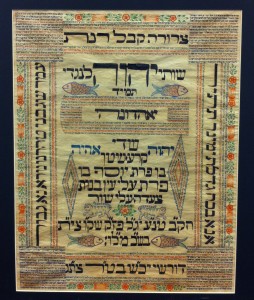Oct
2014
New items in the collection: Shiviti plaques from Morocco and Italy
Shiviti plaque : [Italy?], [twentieth century?]

This type of plaque was usually hung in a synagogue and was meant to exhort the congregation to more devout prayer.
Manuscript, ink and paint on paper. The document is illuminated with colorful biblical scenes and incudes the traditional Shiviti statement “I have set the Lord always before me” (Psalm 16:8) and Psalm 67 written in the design of the seven-branched candelabrum. The biblical scenes on the bottom depict the sacrifice of Isaac (Genesis) and Samson’s struggle with the lion (Judges). On the top are three images: one is David slaying Goliath (Samuel I), in the center are the priests carrying the Holy Ark, and the third is a depiction of the Western Wall in Jerusalem. In the center of the plaque above the two smaller candelabra are depictions of Moses holding the Ten Commandments and Aaron, the High Priest, holding an incense burner. There are biblical scenes on either side of the plaques as well. At the bottom of the document in the center is a statement that the scribe is Amram Asiag bar Masud but no date is given.
Shiviti plaque : [Italy?], [twentieth century?]

Manuscript, ink and paint on paper. The entire text is calligraphed in colorful, decorative micrography. The traditional Shiviti statement “I have set the Lord always before me” (Psalm 16:8) appears in large bold letters on the upper register. Two fish appear in the below God’s name and at the bottom of the plaque; they represent fertility. The text on the document written in Hebrew block letters consists of biblical and liturgical passages that deal with blessing and God’s beneficence. The calligraphy is an integral part of the design of the document. There is a floral border along the outer edge that is beautifully executed and whose color scheme blends in with the art and calligraphy of the plaque. The shiviti is unusual in that it does not contain the seven branch candelabra in calligraphic form that is at the center of most shiviti plaques. The manuscript appears to be Italian because manuscripts from Italy are written in block letters similar to those that appear in this one.
